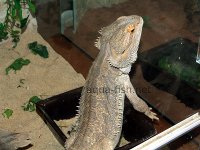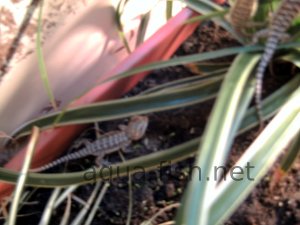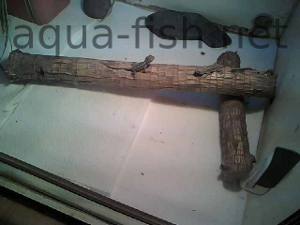Bearded Dragon (Pogona vitticeps) - Care, Pictures and Breeding
Quick links
Introduction
This page is an article dedicated to housing Bearded Dragon (also known as Pogona vitticeps), it's another article that belongs to the "exotic pets" category (articles that aren't dedicated to aquarium fish). You're welcome to share your experiences via form at the bottom of this page!
Pogona vitticeps are more commonly known as the Central Bearded Dragon, or even just the Bearded Dragon, unfortunately there are many species of lizards that share the same common name but the most easily supplied by the pet stores are indeed Pogona vitticeps. They can grow quite large, specimens of up to 18 inches in length are common but note that this measurement is based on the tail length included as well. These are very agile lizards and can raise their body from the ground when running, the benefits if this are a good air flow underneath which is very important in the arid deserts of Australia where their natural habitat is located. They can also use this ability to raise themselves when regulating their overall body temperature.
Wild specimens tend to grow a couple of inches larger than the captive specimens but the wild specimens tend to be shorter lived, a captive lizard can live up to 7 years, in many cases with the correct care they have lived up to 10 years, while a wild specimen may only live for up to 5 years, this is usually a reflection on the way that the lizard has been cared for by the keeper.
As expected their bodies are covered in scales but around both sides of the head and the neck region the scales have been modified into spines, these carry on for the whole length of the body along the sides right to the start of the tail. Their colouration can vary a great deal and they get their common name from a pouch that is located underneath their chin and neck, this is usually darker than the rest of the body, with adult males it is considerably darker.
Like most lizards, they do shed their skins on a regular basis , once shed they may display a different colouration but this is perfectly normal and nothing to worry about, it is not clear yet if they do this to allow them to grow or if it is just a way of removing the old skin to allow fresh new skin to protect their bodies. During this time they may appear restless and the actual shedding can take a few weeks to complete, keeping the lizard moist will help with this but do not attempt to remove the old skin yourself, once the new skin underneath is ready, the old skin will drop away.
In a very similar situation to snakes, these lizards have developed a great sense of taste and smell and they too use their tongues for this purpose, although the action of the tongue is not as obvious as with the snake, but these two senses give the lizard a clear picture of their habitat and what is around them. They can also sense vibrations by laying their bodies on the ground, a useful tool if listening for prey or even predators.
Housing the Central Bearded Dragon
One important point to remember is that Bearded Dragons are solitary creatures, always try to keep one specimen in each enclosure, they do not share their living accommodation well. The enclosure should be at least 4 foot by 2 foot by 2 foot for an adult specimen, this can be a glass aquarium or a container , this should have a lid attached to retain the heat but it also needs to allow air flow of some kind for good ventilation.
Unlike a lot of the reptiles housed in our homes, the substrate choice can be critical when caring for a bearded dragon, they are a very delicate creature with a very delicate digestive system. Using the wrong substrate can allow the bearded dragon to ingest some of the substrate with its food and cause blockages etc. which will have long term effects on the health of your pet. Reptile sands, coral sands, soils and small core gravel must never be used, it is far better to use either a commercial reptile carpet, ceramic tiles, paper towelling or even newspaper for the substrate. These can be cleaned and replaced easily, you can also purchase spare reptile carpet and tiles to place in the enclosure while the soiled substrate is being sanitised ready for use again.
Bearded dragons love to climb so the addition of raised areas or sturdy branches in their enclosure is also a must. If using branches from trees, ensure that they are dried thoroughly over a period of months as some species of trees can contain a sap that is toxic to the lizard. You can even add a pile of rocks set out at different levels, this will serve the same purpose.
Every now and again your bearded dragon will need to hide away so a hide is added to the enclosure, this can be simply an upturned box or a commercial hide, there are many items that you can use as long as they are large enough to provide room for the lizard to enter and leave without too much effort, the addition of these will make the bearded dragon more secure. If your bearded dragon is a young specimen the need for a hide is reduced and can be detrimental, younger specimens are more nervous and may hide away most of the time which means they spend less time under the basking lamp ( basking lamps are covered later in this article), add the hide as the lizard matures and becomes more confident.
Humidity is a key factor in the enclosure, the levels should be set at between 40%-60%, this can be achieved by placing a water bowl in the enclosure, you may find that your bearded dragon rarely drinks from this, the reason for this is that they have the ability to trap moisture from the atmosphere in the scales and guide this down to their mouths, hydrating themselves this way. If you do add a water bowl make sure that the water is changed daily and kept clean, soiled water can lead to infections.
The humidity can be easily monitored by investing in a humidity meter which are readily available from any pet stores that supply reptiles for sale. As we know the water can only make the atmosphere humid if heat is supplied, with the bearded dragons heat mats are not recommended, as the Bearded Dragon spends a lot of time on its belly it can burn itself without realising, it is far better to supply the heat by using a bulb that is fitted at the top of the enclosure and a guard fitted over the unit to prevent any accidents to your lizard. A UV bulb will provide the heat and allow the Bearded Dragon to bask to absorb the required UV rays, these are very important to the lizard and cannot be bypassed. The bulb needs to be switched on for at least 12 hours a day, switched off during the night hours to replicate the natural daylight cycle. The heat that this bulb should bring the enclosure up to a temperature of at least 38°C (100°F), the use of a reliable thermometer placed inside the enclosure will monitor this for you. The use of a dimmer can give you greater control of the temperature that the bulb emits and is a good investment, place the bulb carefully in the enclosure as you also need to provide a cooler area where the lizard has the choice of basking or cooling down.
The importance of a UV bulb cannot be stressed enough, they aid in strengthening the bones of the Bearded Dragon and aid with the growth, the UV bulbs will need replacing after 12 months as they lose their efficiency so make a note of when you fit the bulbs to remind you about this in the future.
Feeding your Central Bearded Dragon
The Central Bearded Dragon is classed as an omnivore so will require a mixed diet of meaty foods and vegetable matter as well as supplying the required vitamins and calcium supplements for strong bone growth. The majority of the diet should be based on vegetable matter which can be supplied from commercial greens and even pieces of fruit that have been chopped down to a suitable size. With juvenile specimens of the bearded Dragon a meat based diet should be provided with just a few greens, the juveniles will also require small meals 2 - 3 times per day to keep them satisfied, if under nourished they may become a bit agitated and nip at their siblings.
Meaty foods should comprise mostly of insects, meal worms or wax worms, any meaty foods that are offered should be gut loaded i.e. feed them first before offering them to the dragons, this will provide twice the nourishment in the same meal. The insect need to be fed with vegetable matter and once fed they should also be dusted with a calcium/vitamin powder, this is especially important for juveniles but for more mature specimens the dusting can be reduced to once or twice a week as their growing stage will have peaked therefore less calcium is required on a constant basis.
Make sure that any food offered has been eaten, all insects or worms definitely need to have been consumed, if any are still present after a couple of hours, remove them from the cage before they spoil the enclosure and increase the risk of infection.
When feeding insects it is best to purchase these from a reliable supplier, if attempting to feed wild caught insects there is always a risk that these have been in contact with pesticides or garden fertilisers which can affect the health of your lizard.
Getting to know your Central Bearded Dragon
Surprisingly the Central Bearded Dragon can become very tame towards its owner and does appreciate a certain amount of handling, only handle if the dragon is settled and not showing any signs of distress. As they mature they will display a docile temperament, with juveniles they do tend to be more skittish and nervous so allow for this. To pick up your Dragon correctly, always place the flat of your hand underneath its belly and slowly pick the lizard aloft gradually placing your hand around its whole abdomen, do this gently to avoid startling the lizard. Always wash your hand after handling as they can carry diseases and toxins that are harmful to humans even though these do not affect the lizard, caution is always the key word.
You may notice that your Central Bearded Dragon may display odd behaviour and perform stances every now and again, many of these are explained quite easily and prove to be interesting to the owner.
Flaring of the throat flap by the male or female is usually a sign of aggression, especially during the breeding season, the Dragon may also widen its mouth to appear even more menacing, this is all just part of the dominance game and the displays are usually enough to prevent any actual physical contact from happening. The next step is normally a constant bobbing of the head, to display submission, the Dragon will raise a foreleg in the air and may even wave it about.
Of course a lot of this behaviour will not be observed when you are keeping a single specimen but when introducing lizards to each other prior to breeding them, displays are a common event.
Breeding the Central Bearded Dragon
If you wish to attempt to breed these creatures there are many success stories so they are definitely not impossible to breed, some keepers can breed them with ease. Of course the first step is to sex the lizards to make sure that you have a healthy male and female to begin with. Sexing the males is quite a straightforward affair, by raising the tail slightly you will observe on the males a hump at either side of the tail, these are commonly referred to as hemipenal bulges and are located just above the ventral opening. The bearded dragons become sexually mature at an approximate age of 2 years but they can be sexed after they are a few months old.
Many breeders will allow their lizards to undergo a period of “brumation”, this is very similar to hibernation but the lizard will not go into a deep sleep. They still remain active but at a much slower pace and still require the same amount of care as normal. This is usually brought about by lowering the temperature by a couple of degrees and the lizard will spend long periods of time resting. This allows the lizard to preserve their strength ready for the ardous task of mating and is very important for the female lizard.
The breeding enclosure needs to have ample space and an area where the female can lay her eggs. Once the brumation period is over the temperature should be raised again and the lizards will become more active, choose a healthy mature pair of Bearded Dragons and once added to the enclosure the male should start to show signs that he is displaying to the female. The most obvious signs are when the male starts to stamp his feet and bob his head a lot to the female, this is usually followed by the male chasing the female around and often grasping her around the neck area.
Eventually mating should take place and after this event the male is no longer required and can be returned to his original enclosure. Gestation can take up to 5 weeks so during this time the nesting area can be prepared, the female will need to dig a pit to lay her eggs into, this can be achieved by adding moist soil or sand to make the digging easier and make sure that the nesting area is in a warm part of the enclosure.
Once the female has laid her eggs you now have the choice as to whether to leave them in the enclosure or place them in an incubator ready for hatching. If using an incubator, the temperature should be set at a range between 27-30°C and the incubation period normally lasts for up to 60 - 70 days. When placing the eggs into the incubator, always keep them in the same position as they were laid, turning the egg can lead to the demise of the embryo. Moist moss or sand can be added to the incubator to keep the humidity level at a high enough reading, if this drops your breeding will all too often prove to be unsuccessful.
Once the embryos have fully formed, the eggs will crack and the young hatchlings will emerge. They will consume the remains of the yolk sac initially so will not require a feeding until after a couple of days.
The young will accept the same diet as their parents but in smaller quantities and on a more regular basis, the may require feeding for 2 - 3 times per day until they grow into juveniles and this can then be reduced to twice a day.
Juvenile bearded dragons
Pictures of juvenile bearded dragons supplied with full permission from www.fishtankforum.co.uk



